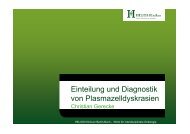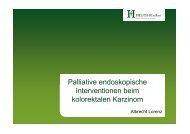Obere Einflussstauung - Tumorzentrum Berlin-Buch
Obere Einflussstauung - Tumorzentrum Berlin-Buch
Obere Einflussstauung - Tumorzentrum Berlin-Buch
You also want an ePaper? Increase the reach of your titles
YUMPU automatically turns print PDFs into web optimized ePapers that Google loves.
Onkologische Notfälle<br />
<strong>Obere</strong> <strong>Einflussstauung</strong><br />
12.9.2012<br />
Fortbildung<br />
TZ <strong>Buch</strong>
<strong>Obere</strong> Einflusstauung
<strong>Obere</strong> Einflusssstauung<br />
Klinische Zeichen
<strong>Obere</strong> <strong>Einflussstauung</strong>:<br />
Superior vena cava Syndrom (SVC)<br />
• Early signs and symptoms<br />
• Signs<br />
• Dilatation of the neck, arm, and chest wall veins<br />
• Oedema of the upper body, extremities, and face<br />
• Symptoms<br />
• Cough and haemoptysis<br />
• Dysphagia<br />
• Chest pain<br />
• Dyspnoea<br />
• Late signs and symptoms<br />
• Signs<br />
• Severe respiratory distress<br />
• Cyanosis<br />
• Engorged conjunctiva<br />
• Convulsions and coma<br />
• Symptoms<br />
• Severe headache and feelings of “tension in the head”—worse in the morning and on bending<br />
down<br />
• Visual disturbance
<strong>Obere</strong> Einflusssstauung<br />
Klinische Zeichen
Konventionelle Bilddiagnostik
Zentraler Venenkatheter und<br />
Kollateralvenenbildung
Superior Vena cava Syndrom
SVC: Ursachen
Therapiemöglichkeiten<br />
• Endovaskulaeres Stenting<br />
• Chemotherapie<br />
• External beam Radiotherapie<br />
• Offene chirurgische Reconstruktion<br />
• Med. Management (Hormon- bzw<br />
Radionuklidtherapie)
Therapie des SVCS
Stent<br />
Characteristics of the stenosis<br />
• Gianturco Z-stent:<br />
• Short, straight stenosis involving large<br />
diameter vessel.<br />
• Wallstent and Memotherm stent:<br />
• Long, curved stenosis involving vessel<br />
with smaller diameter.<br />
• Palmaz stent:<br />
• Short stenosis in locations where stent<br />
migration may pose a problem.<br />
Thorax 2009;64:174-178
SVC: Stentimplantation
Verschluss des Stents durch Tumor/Thrombose
Therapie SVC
Venöser Bypass Graft nach frustraner Rekanalisation
SVC und Schrittmacher
SVCS Stent<br />
indications - contraindications<br />
• Patients with symptomatic superior<br />
vena cava obstruction who have<br />
malignant disease and a short to<br />
medium life expectancy, either at the<br />
initial presentation or after failed<br />
chemotherapy or radiotherapy<br />
• Patients with symptomatic superior<br />
vena cava obstruction secondary to<br />
benign disease<br />
• Patient is asymptomatic<br />
• Patient cannot lie flat or semi-supine<br />
on the table<br />
• Patients with malignant disease that<br />
has a good chance of cure or<br />
remission (such as lymphoma or germ<br />
cell tumour) should be treated with<br />
chemotherapy or radiotherapy first.<br />
Stenting should be reserved for<br />
treatment failure with these modalities
Progrediente Dyspnoe
Onkologisch-kardiologische<br />
Notfälle<br />
Thorax 2009;64:174-178
Therapieoptionen
Fazit<br />
• Das Superior vena cava obstruction Syndrom kann asymptomatisch sein,<br />
die Symptome sind jedoch sehr belastend<br />
• Die häufigsten (>85%) Superior Vena Cava Obstruction Synd. sind Folge<br />
einer malignen Grunderkrankungen am häufigsten des Lungenkarzinoms<br />
• Endovaskulaeres Stenting ist eine sichere und effektive minimal invasive<br />
Technik zur Behandlung einer symptomatischen superior vena cava<br />
Obstruction<br />
• Stenting verursacht eine direkte Symptomlinderung, die rapider (0-72 H)<br />
und umfassender wirkt als eine Radiotherapie oder Chemotherapie alleine.<br />
• Endovaskulaeres Stenting ist die Methode der Wahl bei malignen<br />
grunderkrankungen mit kurzer bis mittlerer Lebenserwartung Es besteht<br />
keine Interaktion oder Komplikatiopnsneigung mit der zugrundeliegenden<br />
Therapie des malignosm.<br />
• Die Symptome können als Folge eines thrombotischen Verschlusses des<br />
Stents erneut auftreten. Es besteht dann die Möglichkeit der Thrombolyse<br />
bzw. einer weiteren coaxialen Stent Implantation.










